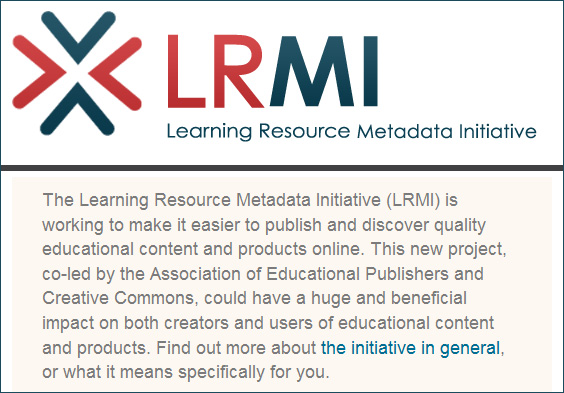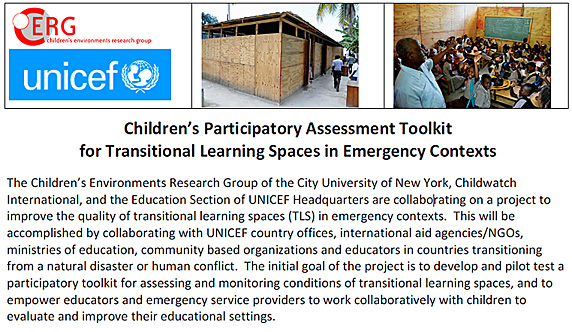
From DSC:
Veeeeery interesting…perhaps Apple is building the Walmart of Education.




Educating the Poor in India: Lessons for America — from EducationNext.org by Peter Meyer
The Learning Resource Metadata Initiative (LRMI) is a project to create a common vocabulary for describing educational content. While there are many benefits to such a project, the main goal of the initiative is improve end-user search and discovery of learning resources. Read below for a general overview or visit our FAQ page for more specific details.
Deficit Supercommittee’s failure triggers steep cuts for education and research — from The Chronicle by Kelly Field
Excerpt:
The Congressional supercommittee charged with cutting $1.2-trillion from the federal budget conceded defeat Monday, after its members reached an impasse over taxes and entitlement spending.
The panel’s failure to produce a deficit-reduction plan triggers across-the-board cuts of roughly $1-trillion in discretionary spending over nine years, starting in the 2013 fiscal year. Unless Congress finds a way around the process, the Education Department’s budget will be slashed by $3.54-billion in 2013, according to the Committee for Education Funding, an advocacy group.
While the Pell Grant program is exempt from cuts in the first year, the other student-aid programs will lose $134-million, reducing aid to at least 1.3 million students. Career, technical, and adult education will lose $136-million, affecting 1.4 million students, says the committee.
Studying teacher moves — educationnext.org by Michael Goldstein
A practitioner’s take on what is blocking the research teachers need
Excerpt (emphasis DSC):
But there is almost nothing examining the thousands of moves teachers must decide on and execute every school day. Should I ask for raised hands, or cold-call? Should I give a warning or a detention? Do I require this student to attend my afterschool help session, or make it optional? Should I spend 10 minutes grading each five-paragraph essay, 20 minutes, or just not pay attention to time and work on each until it “feels” done?
…
My point is simply that relative to education policy research, there is very, very little rigorous research on teacher moves. Why? Gates knows it’s more than a lack of raw cash; it’s also about someone taking responsibility for this work. “Who thinks of it [empirical research on teachers] as their business?” he asked. “The 50 states don’t think of it that way, and schools of education are not about [this type of] research.”
I agree, but I contend there are a number of other barriers. The first is a lack of demand.
…
A second issue is that researchers don’t worry about teacher time. Education researchers often put forward strategies that make teachers’ lives harder, not easier. Have you ever tried to “differentiate instruction”? When policy experts give a lecture or speak publicly, do they create five different iterations for their varied audience? Probably not.
An educational system built for another time, another student demographic — by Lloyd Armstrong, University Professor and Provost Emeritus at the University of Southern California
Excerpt:
…This is probably because much of our education system originally was designed around the traditional student and his or her needs, and the leading institutions in the system still serve primarily the traditional student. As a consequence, potential changes in educational approach or organization are most often judged according to whether or not they will benefit those traditional students who enjoy the benefits of residential life and a manageable financial burden. But, as this report describes, times have changed, the composition of the student body has changed, and because many of our institutions have not changed accordingly, the results are not pretty.
In particular, the report focuses on the plight of part time students, and shows that graduation rates for part time students at all levels – certificates, associates, and bachelors – are only about 40% as high as for full time students (if one looks at a time period twice the nominal period required for graduation). Graduation rates for both full time and part time students who are African-American, Hispanic, older, or low income are considerably lower than for the general student body, and the part-time “penalty” is somewhat higher than for the general population.
…
All in all, a very important report, with sensible and meaningful recommendations. I can’t give it an A, however, because I think its basic conclusion in not bold enough – and maybe not even correct. The recommendation is basically to fiddle the system to enable part time students to behave more like full time students, assuming that if they can behave more like full time students they will graduate like full time students. That is not a bad idea, of course, but why not start from the premise that the system itself needs to be redesigned so that it focuses on the needs of the part time students? Maybe the problem is not simply the full time/part time divide, but that the system responds or does not respond to the many and highly varied needs of part time (and by extension, non-traditional) students.
From DSC:
Nice report — well done. My only wish here would be that the costs of obtaining an education were discussed more — as one of the causes of this issue but also a potential/significant piece of the solution. I think cost is one of the key factors as to why more students are becoming part-time students — and thus are more likely susceptible to “life getting in the way.”
There was some mention of this in the solution proposed — which was good to see:
4. Restructure programs to fit busy lives. It’s time to face facts: College students today are going to have to work while trying to graduate. What else can they do when college is so expensive? (emphasis DSC)
Public school choice pushed in Michigan — from EdWeek.org by Sean Cavanagh
At a time when many states are adopting controversial measures to launch or expand private school vouchers, Republicans in Michigan are taking a different direction, moving ahead with a plan that would greatly expand the menu of public school choices for students and parents.
GOP lawmakers, who control both state legislative chambers, have introduced a series of proposals that would give students more freedom to attend schools outside their districts, increase options for taking college classes while in high school, and encourage the growth of charter schools and online education offerings. (emphasis DSC)
Many of those proposals mirror the stated priorities of first-term Gov. Rick Synder, a Republican, who earlier this year called for establishing “open access to a quality education without boundaries.” He described the idea as an “any time, any place, any way, any pace” model. (emphasis DSC)
It’s time to take the black male achievement crisis seriously — from good.is Liz Dwyer
Excerpt:
Despite the dire statistics on how the education system fails black males—only 50 percent of them graduate from high school—the issue generally isn’t addressed with a sense of urgency. So veteran broadcaster Tavis Smiley has committed to spending the next year asking tough questions and finding solutions to the problem. He kicked off the effort last night with “Too Important to Fail,” an hour-long PBS special featuring interviews with education experts and black male students in Chicago, Philadelphia, Oakland, and Los Angeles.
Also see:
Addendum on 9/20/11:
10 salient studies on the arts in education — from onlinecolleges.net
Excerpt:
A fine arts education — including music, theater, drawing, painting, or sculpture — whether in practice or theory, has been a part of any well-rounded curriculum for decades — but that may be changing. Many schools today are cutting back or eliminating their art programs due to budget constraints. It is estimated that by the end of this year, more than 25% of public high schools will have completely dismantled them. These stats aren’t just bad news for teachers working in the arts. Numerous studies done over the past decade have demonstrated the amazing benefits of such an integral education facet. Students who don’t have access to art classes may not only miss out on a key creative outlet, but might also face greater difficulty mastering core subjects, higher dropout rates and more disciplinary problems.
You don’t have to take our word for it — you can read the studies yourself. Here, we’ve listed some of the biggest on the arts in education conducted over the past decade. Taken on by research organizations, college professors and school districts themselves, the studies reveal the power of art to inspire, motivate and educate today’s students. And, of course, demonstrate what a disservice many schools are doing by undervaluing such an integral part of their education and development (emphasis DSC).
First day of school: Anastasis Academy #standagain — from iLearnTechnology.com
Today was one for the books. We did it! We opened a school with a radical new vision for what a school should look like in light of learning. It was a truly great day!
Mission:
[Anastasis Academy’s mission] is to apprentice children in the art of learning through inquiry, creativity, critical thinking, discernment and wisdom. We strive to provide an educational model that honors and supports children as the unique and creative individuals that God created them to be. We work to shape the development of the whole-child by engaging the mind, body and spirit while inspiring each to personal excellence.
Also see:
Look where you want to go and steer in that direction: How a blog started a school — from Dreams of Education (6/24/11)
From DSC:
24 “The LORD bless you and keep you; 25 the LORD make his face shine on you and be gracious to you; 26 the LORD turn his face toward you and give you peace.” (Numbers 6:24-26) May He bless your efforts as you seek to not only impact the minds of — but also the hearts of — your students.
We really need to impact both in order for our future students to make significant, positive impacts around the globe. Way to go Kelly!
Web site lets you compare Michigan high schools’ success — Detroit Free Press by Lori Higgins
Also see:


